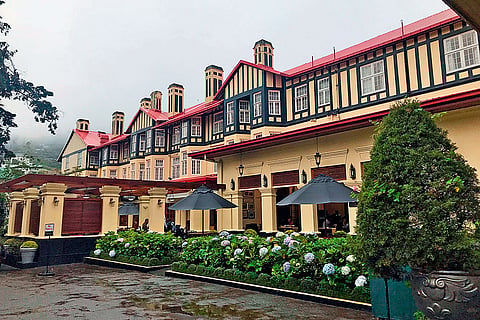
- Destinations
- Experiences
- Stay
- What's new
- Celebrating People
- Responsible Tourism
- CampaignsCampaigns
- Subscribe
- Buy Now

As I entered Nuwara Eliya, the heart of Sri Lanka’s southern hill country, the hot and humid climate of the island’s interior swiftly gave way to a refreshing chill. The roads started to twist and turn precariously up the lush green hills, leading towards the cool, misty clouds in between. The landscape transformed from palm trees and wetlands to majestic forests of delicate, towering eucalyptus trees.
Nestled amidst lush, tea-covered hills and beneath the towering Pidurutalagala Mountain, Nuwara Eliya is often referred to as Sri Lanka’s “Little England” due to its resemblance to a quaint English country village and its Victorian-era architecture. Although the Kandyan Kingdom once occupied the region, the town has a distinctly British flavour, established as a retreat by Sir Edward Barnes in the mid-19th century.
***
As I passed through the gates of the Damro Labookellie tea factory, 15 km from the city centre, I was met with the sight of a towering four-storey building made of concrete with a faded green tile roof. Despite the addition of a shiny new visitor centre, the factory seemed to have remained unchanged for the past several decades.
The workers inside the factory–mainly women–held bags filled with freshly picked tea leaves, ready to be weighed and valued. Outside in the tea gardens, with scarves wrapped around their heads, tea pluckers worked away on the terraces where the land dropped into the valley below.
Post the factory visit, since I wanted to immerse myself in colonial-era Nuwara Eliya, I set off to the Grand Hotel, a nearly 200-year-old establishment that used to be the holiday residence of Barnes. The deliciously languid high tea, served at 3 pm sharp every day, completed the experience.
While I snacked on various savoury and sweet items, including bite-sized tandoori wraps, smoked salmon and cucumber sandwiches and classic cream scones, composed servers donning waistcoats and white gloves offered endless cups of tea.
Next on my agenda was the man-made Lake Gregory, established by Sir William Gregory, the governor, in 1873. The lake extends from the southern end of Nuwara Eliya to the foothills of the surrounding terrain. The western shore’s pathways and lawns provided a delightful setting for an evening walk.
If you are someone who has read the Ramayana, visiting the Seetha Amman Temple is a must-visit. The temple is six km outside the city and can be reached by road to Ella. My tour guide charged INR 450 to take me to and from the city centre. The temple, built in the traditional Tamil style, is believed to be over 2,000 years old. According to legend, Goddess Sita worshipped her husband, Lord Rama, every day while waiting for him to rescue her. Hanuman eventually arrives at the temple to speak with her and is said to have left his footprints on the rocks near the stream.
Finally, I didn’t want to miss out on the post office in the city’s centre, one of the oldest in Sri Lanka and fully operational. Interestingly, the upper floor of the building used to serve as the postmaster’s residence for an extended period, but it has since been transformed into a tourist accommodation.
While Nuwara Eliya initially appeared to be a town steeped in English culture, a closer look revealed that this façade is mostly superficial. Despite some English influences, at its core, Nuwara Eliya remains a distinctly Sri Lankan town, bustling with noise and activity, from the dusty bus station and the whizzing tuk-tuks to the vibrant temple and the orange-robed monks that congregate outside.
To reach Nuwara Eliya, the easiest way is by train, with Nanu Oya being the nearest station, 5 km away. Although local buses can transfer passengers to Nuwara Eliya, taking a tuk-tuk would be faster and cost approximately INR 500-600. Nuwara Eliya’s bus station is in the town centre and serves all major Sri Lankan cities.
Nuwara Eliya experiences regular rainfall all year round because of its high elevation, except February, which tends to be the driest month. Visitors should know that the area can get quite cold during the winter, particularly at night.
